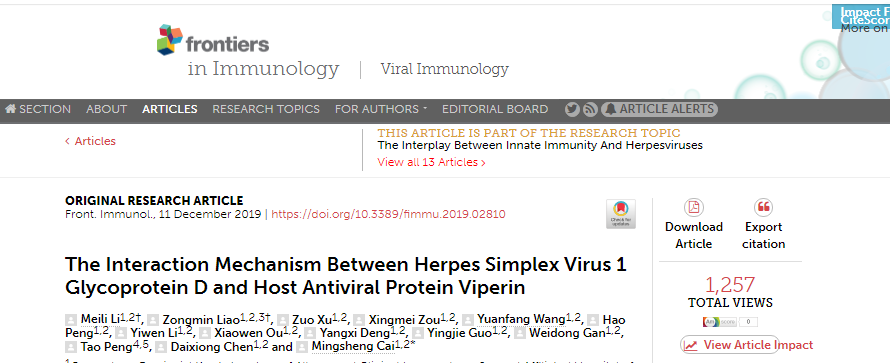
Front. Immunol., 11 December 2019 DOI: https://doi.org/10.3389/fimmu.2019.02810
The Interaction Mechanism Between Herpes Simplex Virus 1 Glycoprotein D and Host Antiviral Protein Viperin
Meili Li, Zongmin Liao, Zuo Xu, Xingmei Zou, Yuanfang Wang, Hao Peng, Yiwen Li, Xiaowen Ou, Yangxi Deng, Yingjie Guo, Weidong Gan, Tao Peng, Daixiong Chen and Mingsheng Cai
1 Guangdong Provincial Key Laboratory of Allergy and Clinical Immunology, Second Affiliated Hospital of Guangzhou Medical University, Guangzhou, China
2 Department of Pathogenic Biology and Immunology, School of Basic Medical Science, Sino-French Hoffmann Institute, Guangzhou Medical University, Guangzhou, China
3 Department of Scientific Research and Education, Yuebei People's Hospital, Shaoguan, China
4 State Key Laboratory of Respiratory Diseases, School of Basic Medical Science, Sino-French Hoffmann Institute, Guangzhou Medical University, Guangzhou, China
5 South China Vaccine Corporation Limited, Guangzhou, China
Abstract
Viperin is an interferon-inducible protein that responsible for a variety of antiviral responses to different viruses. Our previous study has shown that the ribonuclease UL41 of herpes simplex virus 1 (HSV-1) can degrade the mRNA of viperin to promote HSV-1 replication. However, it is not clear whether other HSV-1 encoded proteins can regulate the function of viperin. Here, one novel viperin associated protein, glycoprotein D (gD), was identified. To verify the interaction between gD and viperin, gD and viperin expression plasmids were firstly co-transfected into COS-7 cells, and fluorescence microscope showed they co-localized at the perinuclear region, then this potential interaction was confirmed by co-immunoprecipitation (Co-IP) assays. Moreover, confocal microscopy demonstrated that gD and viperin co-localized at the Golgi body and lipid droplets. Furthermore, dual-luciferase reporter and Co-IP assays showed gD and viperin interaction leaded to the increase of IRF7-mediated IFN-β expression through promoting viperin and IRAK1 interaction and facilitating K63-linked IRAK1 polyubiquitination. Nevertheless, gD inhibited TRAF6-induced NF-κB activity by decreasing the interaction of viperin and TRAF6. In addition, gD restrained viperin-mediated interaction between IRAK1 and TRAF6. Eventually, gD and viperin interaction was corroborated to significantly inhibit the proliferation of HSV-1. Taken together, this study would open up new avenues toward delineating the function and physiological significance of gD and viperin during HSV-1 replication cycle.
文章链接:https://www.frontiersin.org/articles/10.3389/fimmu.2019.02810/full